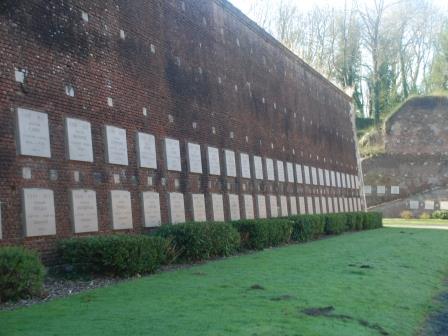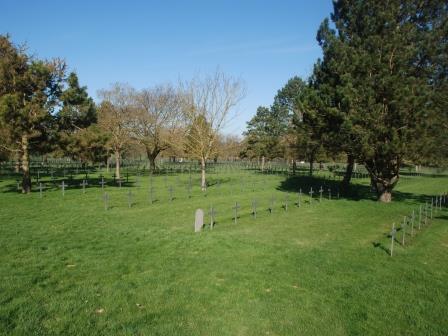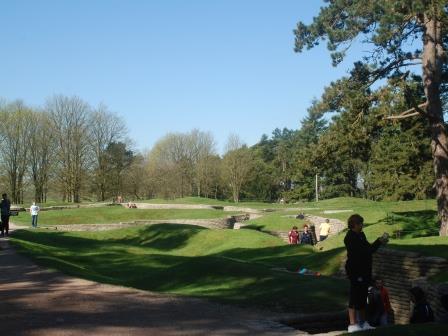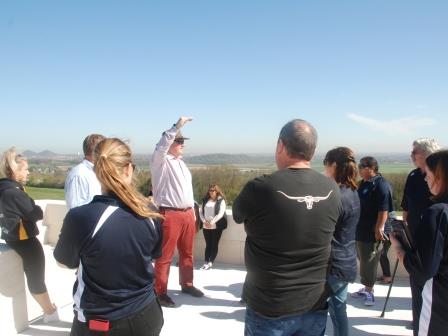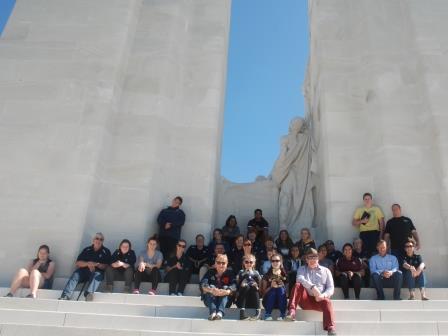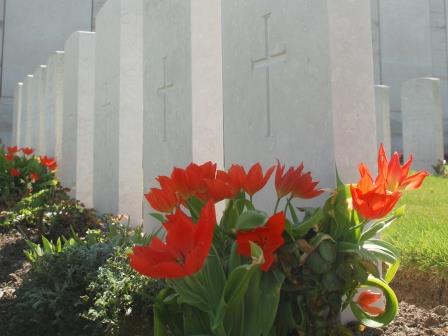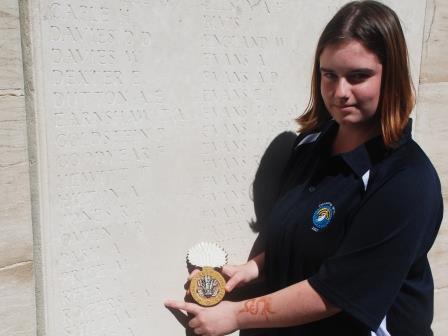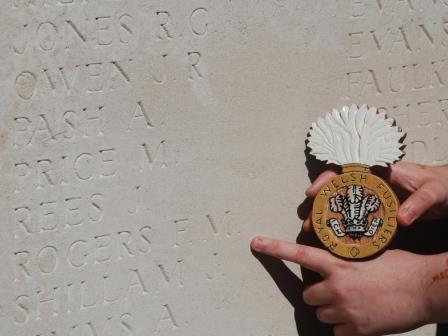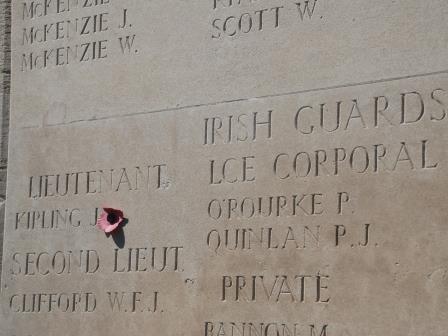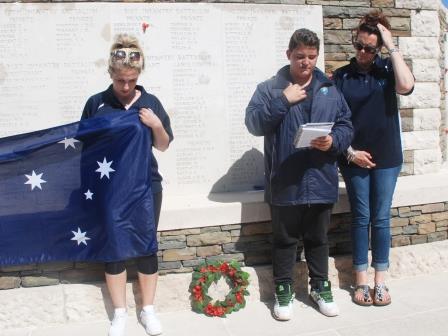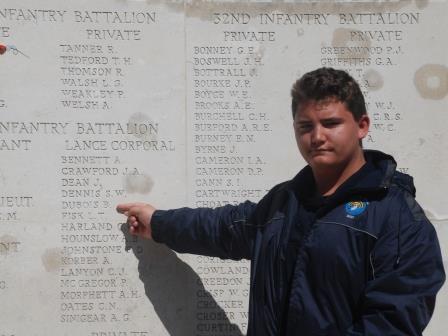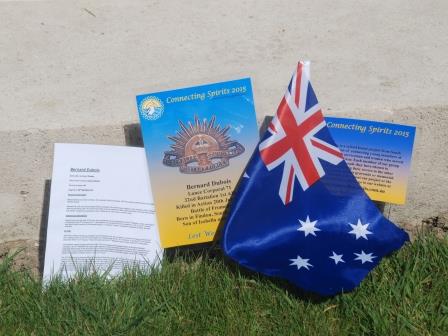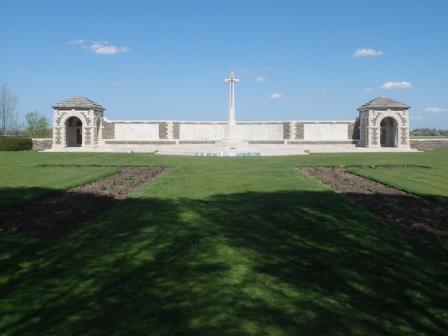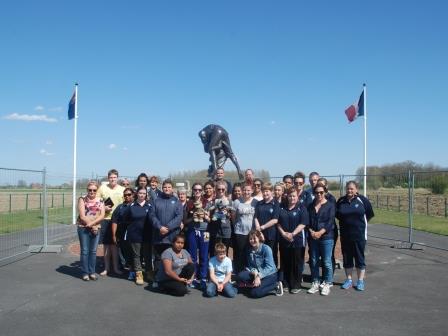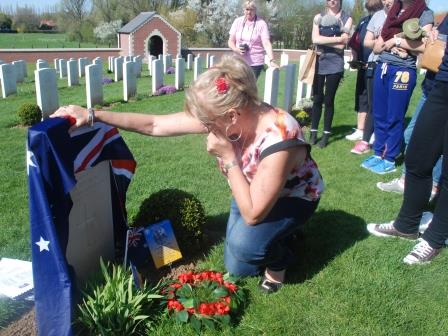April 15th
Day 9 15th April Arras to Ieper via Fromelles
Jackie’s husband Rod joined as guide this morning. Rod has worked with Connecting Spirits since 2006, and with Julie at Mt. Barker before that. He has a fantastic knowledge of the Western Front as a whole but also has a great understanding of the war from an Australian perspective.
Our first stop for the day was the Citadel at Arras. This massive structure was built from the 1600’s to defend France against both external and internal enemies. During World War 2 it was used as a headquarters for the German Army for the whole of the Northern France region. Many resistance fighters and Allied spies were caught and spent their final hours or days in these buildings. After being tortured to the point that they could no longer reveal anything of value they were then taken into an area between the outer and inner ramparts and shot. Their memorials, about 250 of them, line the path from the main area to the shooting post.
We then travelled north and on the way passed closely by the French Memorial at Notre Dame De Lorette which we visited 2 days earlier. We passed another French Cemetery with over 20,000 graves, all white crosses laid out in beautiful symmetry so that in whichever direction you looked they were all lined up in rows. Not far from here is the German Cemetery of Neuville St. Vaast. Again the number of crosses in this place seemed to be endless and the fact that many of them held the name of not one but up to four individual names is mind blowing.
Our next stop was not far from here at Vimy Ridge. This is the scene of the attack on April 9th 1917 that proved to be successful in capturing the high ground that denied the Germans of the view behind the Allied lines and also gave the Allies a 40 mile view of the Plains of Douai beyond. Relatively small gains of territory can provide massive strategic advantage in some cases. The Canadian Government had great foresight in purchasing large amounts of land both here and at Beaumont Hamel, leaving them largely untouched to provide both a memorial to the feats of their soldiers and an educational resource like no other. Canadian students do 6 months volunteer stints here and act as guides. It is a shame that our government didn’t do the same with a parcel of land near Pozieres. We have and are spending millions of dollars at places such as Fromelles, Bullecourt and Villers-Bretonneux which are important sites, but as we saw, more men from right across Australia lost their lives at Pozieres than anywhere else, and yet there is very little recognition of this there. I hope that the government sees the error of this soon and acts to correct this oversight. (Rant Over). The Vimy Ridge area included a number of tunnels, again to allow for surprise during the attack on the 9th April, and again we toured through these getting a perspective of the war underground. The original trench lines are also in place as they are at Beaumont Hamel so you get a real understanding of the feats of the men who captured them not to mention the shell holes and mine craters that give an insight into the hell that must have been above ground at that time.
From here we walked to the Canadian Memorial to the missing, which is an amazingly beautiful structure that commemorates those Canadians that fell in France and do not have a known grave.
We then made our way to Lens for lunch at the Flunch. Flunch is a type of restaurant chain that serves good meals at a reasonable price. It is a type of buffet arrangement where you select the side dishes and drinks you want, then go through the check out and order and pay for some hot food then go to the next counter and collect your meal. Of course it is all in French, but the serving staff do their best to understand us and to explain as best they can what to do. Most of us ended up with what we wanted!!!
After lunch we went to Loos, the scene of a massive battle in September 1915. Rudyrad Kipling lost his only son in this battle and if you have read the book ore seen the film, “My Boy Jack” you would know the story. We had another commemoration here which was beautifully done by Sam.
From here it was onto Fromelles, the scene of Australian history’s most bloody day. The 5rth Division of about 10,000 men attacked here on the 19th July 1916, the first major engagement by Australians on the Western Front. 5533 of them became casualties in the next 12 hours, including almost 2000 dead. At VC Corner the names of about 1200 of those with no known grave are recorded and in the two rose gardens in front lie the remains of 410 Australians whose remains were brought in from No Man’s land by locals after the war. Nathan commemorated Bernard DuBois here. We then went into the town of Fromelles and visited the new museum there. This has been built by the Australian Government and is situated next to the Pheasant Wood Cemetery which holds the remains of the 250 soldiers who were found in a mass grave nearby after being unknown for over 90 years. Our Friends Carole and Pierre met us there and gave us some extra insight into the displays and the battle.
We then moved into the cemetery and commemorated Ray Pflaum, a Birdwood boy who has been commemorated on every Connecting Spirits trip, originally at the wall of Villers-Brettoneux, but now by his own grave as he was identified by DNA matching.
From here we drove in to our old favourite town, Ieper. For the experienced campaigners of Connecting Spirits this town is like a second home. It is beautiful and has the feel of a medieval town, but the locals usually speak English well and are very welcoming of Australians who come to pay their respects. It is safe and easy to walk around and oozes both history and charm. Do yourself a favour and get over here!!!
Tamika Williams
We are leaving Arras today, and I keep thinking about my visit to the Wellington Tunnels. I don't think I can quite find a word to describe that place. The damp quarry was indeed full of memories, although not my memories. I can nearly imagine the laughs and the "good times" that the soldiers would have had before the sunrise on the 9th April 1917, the day they broke out into no-man's land and surprised the Germans. I can't even start to imagine the last moments in the quaryy before they ran out. I got shivers asa we exited the quarry, and I knew then that this was one of those places, a place that I will always remember, I place that I connected with most. A place where I knew soldiuers had peace for the 8 days they were down there before stepping out, not knowing their fate, and not knowing if they were going to see the soldier standing right next to them again.
Sam Crow
When I did my commemoration at Loos Memorial I was very nervous speaking in front of a group of people I had only just met. I also kept wondering if I had done enough? For my commemoration of Frank Maybury I made a wooden carving in the shape of Frank's regimental insignia, the Royal Welsh Fusiliers. I am sending the carving to my aunt so she can have something to represnt the connection with her great uncle and we can all know ands say that we have not and will not forget.
Shania Weetra
Connecting Spirits isn’t just about commemorating your relatives, it’s about commemorating the soldiers that served our country, and also finding connection with your family. Connecting Spirits. Lest We Forget.
Trae Rigney
Having to know Nathan for only 9 days really, he has stood strong by standing in front of his peers commemorating his soldier. It's not an easy thing to. Proud of you Nathan.
